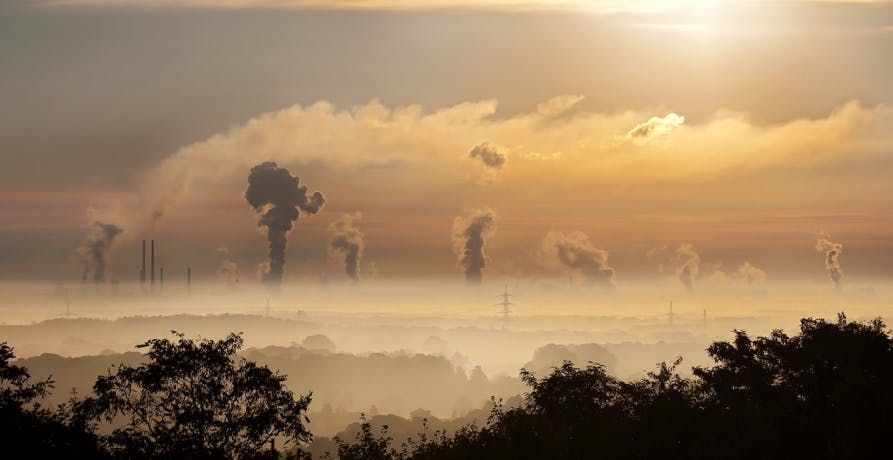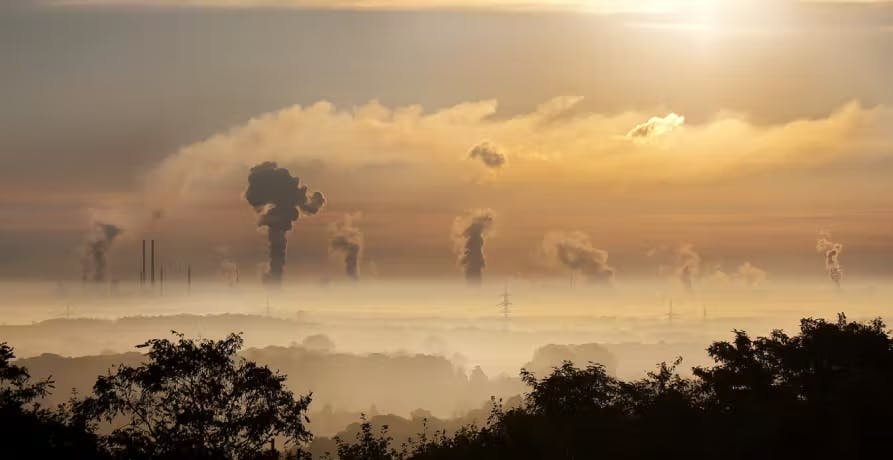ESG / CSR
Industries
What is the Greenhouse Effect?



Greenhouses are exceptional at letting light in and staying warm at the same time. The greenhouse effect, named for the successful method of growing plants indoors, has a significant impact on the Earth's global temperature and climate. Greenhouse gas emissions contribute to the greenhouse effect and further warm the earth.
According to the Intergovernmental panel on climate change, global greenhouse gas emissions are on the rise due excessive human activity. Therefore, it is more important than ever to understand how carbon dioxide and other greenhouse gases contribute to global warming.
What is the greenhouse effect? What are the major greenhouse gasses? And how are the gases influencing global warming?
What is the greenhouse effect?
Greenhouse effect, definition
The definition of the greenhouse effect is when certain gases in the earth's atmosphere trap sunlight and stop it from returning to space, warming the earth.
What causes the greenhouse effect?
The greenhouse effect is caused by warm or hot air not being able to escape an enclosed space.
The greenhouse effect works on a smaller than planetary scale, too. As mentioned earlier, the effect is named after a greenhouses: glass-walled buildings where plants can grow in a climate-controlled environment. Just like earth's atmosphere, greenhouses let in light and trap the sun's heat.


How does the greenhouse effect work?
An understanding of the electromagnetic spectrum helps to better grasp the greenhouse effect.
Electromagnetic energy travels in various forms and shapes with different wavelengths and frequencies that determine the type of energy, such as greenhouse gas concentrations or fossil fuel combustion.
Humans can only perceive a tiny sliver of the spectrum with the naked eye. However, we use a variety of the wavelengths in our everyday lives, such as x-rays, microwaves, and radio waves.
Greenhouse effect examples
When it comes to the greenhouse effect, let's take the examples of the sun warming a car and the sun warming a greenhouse. Visible light passes through the glass and warms objects inside of the glass. The light heats up the objects which then give off infrared light.
This infrared light, which can be felt as heat, has too long of a wavelength to pass back through the glass, getting trapped inside of the car or greenhouse. This is also known as infrared radiation.
Greenhouses work well to offer a good habitat for growing plants because they let the visible light in but trap the residual heat. However, growers need to be aware of trapping too much heat, particularly in the summer – that's why you might see a greenhouse with its doors open or plastic walls rolled up to let the excess heat out.
The greenhouse effect is also why a car gets hot when it sits in the sun. Have you ever cracked the window of your parked car to keep it cool? By doing this, you limit the impact of the greenhouse effect by letting the hot air escape the inside of the car.
Is the greenhouse effect good or bad?
We cannot say that the greenhouse effect is particularly good or bad, but we know for sure that excessive carbon dioxide emissions and greenhouse gases emitted aren't good for the planet.
The greenhouse effect is necessary for the survival of humans and nearly all other species on earth. Surface temperatures on our planet would be about 33°C (60°F) cooler if the greenhouse effect didn't exist.
As you might expect, too many greenhouse gases in the earth's atmosphere would make surface temperatures scorching hot and species survival futile.
The earth is livable for millions of species because the density of greenhouse gases in the earth's atmosphere is the right concentration to keep the earth's surface at a stable temperature that is not too hot nor too cold. However, as more and more greenhouse gases are released into the atmosphere, earth will heat up and threaten the existence of millions of species


What are greenhouse gases?
Greenhouse gases, also known as “GHG”, are atmospheric gases that trap heat from sunlight reflecting off the earth's surface.
Greenhouse gases are naturally occurring and help keep earth's surface temperature at a stable, warm level. Sunlight and greenhouse gases are the essential components of the greenhouse effect.
Since the start of the industrial revolution, humans have been releasing additional greenhouse gases into the atmosphere, changing the gas composition of our air.
As more greenhouse gases have been added to our atmosphere, our global temperatures have also risen. This is because more greenhouse gases in the atmosphere will further insulate heat from the sun.
A real-world example is when you put on a second or third layer to stay warm when it is cold outside. You may already be wearing a sweater to insulate your body heat, but if you are still cold, you may put on a jacket to keep even more of your heat close to your body.
When we burn more fossil fuels, we are slowly adding more metaphorical layers of clothing to the earth.
Which gases contribute to the greenhouse effect?
While there are many types of greenhouse gases, the following are the main examples. Examples of greenhouse gases:
• Carbon dioxide (CO2)
• Nitrous oxide (N2O)
• Methane (CH4)
• Ozone (O3)
• Water vapor (H2O)
• Chlorofluorocarbons (CFCs)
U.S. greenhouse gas emissions
The United States emitted far more carbon dioxide than other greenhouse gases in 2020.
All of these gases are naturally occurring in earth's atmosphere, aside from CFCs. These harmful compounds, also known as fluorinated gases, are only present due to human activity. They also happen to be incredibly powerful: they are 10,000 times as effective at absorbing light as CO2.
How are humans affecting the greenhouse effect?
Humans have been intensifying the greenhouse effect since the industrial revolution when humans started burning fossil fuels like coal to power factories. Since then, our society has learned to rely heavily on natural gas and oil for our common needs: from air travel, to daily travel, to home heating, to charging our electronics. All of these activities are causes of major greenhouse gases.
As we've discussed, the burning of fossil fuels releases greenhouse gases to the atmosphere, further compounding the greenhouse effect. The meat industry has also been known to be bad for the greenhouse effect. Cow can emit literal tons of methane through farts and burps, particularly when the cows are on a poor diet. Ultimately, more carbon dioxide emissions contribute to excessive climate change – and aren't good for the planet.


Gas makeup of earth's atmosphere now compared to past
According to the Mauna Loa monitoring station, the Clevel in our atmosphere is currently about 419 parts per million (ppm). This means that in one million particles of air, 419 of those particles are CO2.
In 1958, when modern measurement techniques began, there were 315 ppm of CO2. It has been estimated that there were 270 ppm of COin 1750.
This means that human activities since the industrial revolution have increased the amount of CO2 in our atmosphere by 150%.
While 416 parts of one million may not seem very significant, even the slightest of changes in the gas makeup of our atmosphere can significantly alter the surface temperature on earth. The earth has already warmed 0.9°C (1.6°F) since preindustrial times and will continue to heat up if we do not limit our greenhouse gas emissions. That is why the Paris Climate Agreement brought together several countries to agree to cut down emissions in order to stop global warming at 1.5°C (2.7°F).
What is the runaway greenhouse effect?
The runaway greenhouse effect is a process by which enough greenhouse gases collect in a planet's atmosphere to trap most or all heat from leaving the planet, resulting in a planet so hot that all water evaporates from its surface.
The water vapor then sits in the atmosphere until it eventually diffuses into space, rendering the planet water-less.
Could the runaway greenhouse effect happen on earth?
Luckily, scientists do not believe human-driven climate change can result in the runaway greenhouse effect – the surface temperature of our oceans will not become warm enough to trigger the effect.
What reduces the greenhouse effect on earth?
Aside from making an effort to reduce greenhouse gas emissions, a great way to limit the earth's intensifying greenhouse effect is to capture excess carbon dioxide. Striving to mitigate fossil fuel combustion, burning fossil fuels, or aiding in the production of other greenhouse gases or greenhouse gas molecules can help to reduce the Earth's average surface temperature. You may know or be able to guess the most effective way to reduce atmospheric carbon dioxide. These beings also happen to be our best source of breathable oxygen.
That's right, plants are our best fighter against the worsening greenhouse effect When companies say they are offsetting their carbon footprint, they often plant trees to do so. That is because trees breathe in carbon dioxide with photosynthesis and breathe out oxygen – the opposite of humans.
Planting trees can help mitigate the warming temperatures caused by greenhouse gas emissions by capturing the gases themselves.
What about Greenly?
If you are passionate about limiting our earth's global temperature rise, mitigating our impact on the greenhouse effect, and tracking and reducing your carbon emissions, contact the team at Greenly. We help companies measure and reduce their carbon footprint, as well as find legitimate carbon offsetting projects to invest in.
Join us in the fight against climate change, along with the hundreds of other companies we have advised on carbon emissions.


